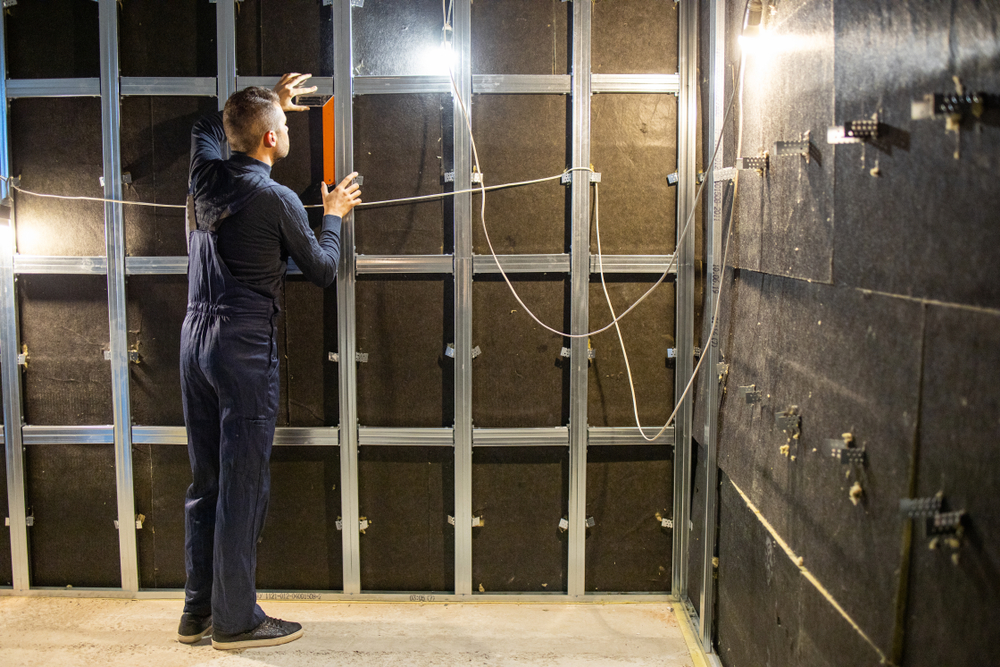What Are Isolation Clips?
Some of the most effective soundproofing tools are isolation clips. These tiny metal and
rubber clips fit into a furring or hat channel and are used in decoupling to reduce the
amount of noise transferred from one room to the next. However, it can be tricky to
understand exactly how they work. Before we look at the specifics of these
soundproofing products, let's start with the basics. How does sound move, and what is
decoupling?
How Does Sound Move?
Sound moves by transferring its energy into particles. When you speak, sound waves
compress the air, causing air particles to bump into each other, transferring this energy
between them. This is why sound cannot travel in a vacuum like in outer space.
However, air is a bad medium for sound to move through. In a solid substance such as
wood or drywall, the particles are much closer together, making it easier for sound to
move. When sound travels through a solid substance it is called vibration, and less
energy might be lost based on the material, allowing the sound to travel further and with
more strength. This is why it is easier to hear someone on the other side of a door who
is knocking on the door than it is to hear them speaking.
What Is Decoupling
Since sound can travel easily between solid objects such as walls, how do we prevent
noise from one room from being heard in the adjacent room? While the most effective
solution would be to create a vacuum around the room, this isn’t practical. Instead, there
are many soundproofing and acoustic treatment solutions to lessen the transfer of
sound.
One of the most effective methods of soundproofing is decoupling. Decoupling is the
separation of two rigid construction materials with damping and isolation characteristics the air gap between the studs or joists as airborne sound or through the isolation clips and furring channel. When transferring through the isolation clips and furring channel. The sound loses much of its
energy, making it much quieter and more difficult to hear
What Is Decoupling
Since sound can travel easily between solid objects such as walls, how do we prevent
noise from one room from being heard in the adjacent room? While the most effective
solution would be to create a vacuum around the room, this isn’t practical. Instead, there
are many
soundproofing and acoustic treatment solutions to lessen the transfer of sound.
Sound Isolation Clips
An ideal solution to perfectly soundproofing a room would be to have it floating in a
vacuum or completely surrounded on all sides by acoustic absorbing material. However,
this isn't a feasible solution and would be incredibly expensive to implement. A much
simpler and nearly as effective solution to soundproofing is using isolation clips. Sound
isolation clips on the studs or ceiling joists will greatly reduce vibration. This means that
sound will lose much of its energy as it passes through the clips, hat channel, and drywall.
Isolation clips provide vibration insulation and reduce impact noise, making them ideal
for use when constructing a garage, laundry, or room with heavy machinery. Unlike
acoustic wall panels and fabrics, they are not easy to add to a room after construction,
and must be part of the original design or added during a serious renovation. After all,
these clips are attached to joists and studs between the walls.
While it is impossible to build a room with no walls/floors/ceilings touching another
room, you can create a “floating” room with isolation clips and hat channels. > Soundproofing a wall
or ceiling using clips and furring channel is an
economical option to reduce voices, music, and
walking noise. Start by installing high-density
insulation, such as mineral wool, in walls and
ceiling. Install one or two layers of drywall
fastened to the furring hat channel to enjoy a
quiet room in your home or office.
For a detailed explanation on how to install sound isolation clips, check out our blog on
How To Install Kinetics IsoMax Clips on Ceilings & Walls.
|

